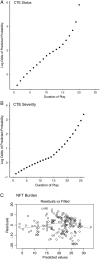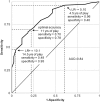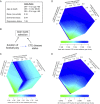Duration of American Football Play and Chronic Traumatic Encephalopathy
- PMID: 31589352
- PMCID: PMC6973077
- DOI: 10.1002/ana.25611
Duration of American Football Play and Chronic Traumatic Encephalopathy
Abstract
Objective: Chronic traumatic encephalopathy (CTE) is a neurodegenerative disease associated with exposure to contact and collision sports, including American football. We hypothesized a dose-response relationship between duration of football played and CTE risk and severity.
Methods: In a convenience sample of 266 deceased American football players from the Veterans Affairs-Boston University-Concussion Legacy Foundation and Framingham Heart Study Brain Banks, we estimated the association of years of football played with CTE pathological status and severity. We evaluated the ability of years played to classify CTE status using receiver operating characteristic curve analysis. Simulation analyses quantified conditions that might lead to selection bias.
Results: In total, 223 of 266 participants met neuropathological diagnostic criteria for CTE. More years of football played were associated with having CTE (odds ratio [OR] = 1.30 per year played, 95% confidence interval [CI] = 1.19-1.41; p = 3.8 × 10-9 ) and with CTE severity (severe vs mild; OR = 1.14 per year played, 95% CI = 1.07-1.22; p = 3.1 × 10-4 ). Participants with CTE were 1/10th as likely to have played <4.5 years (negative likelihood ratio [LR] = 0.102, 95% CI = 0.100-0.105) and were 10 times as likely to have played >14.5 years (positive LR = 10.2, 95% CI = 9.8-10.7) compared with participants without CTE. Sensitivity and specificity were maximized at 11 years played. Simulation demonstrated that years played remained adversely associated with CTE status when years played and CTE status were both related to brain bank selection across widely ranging scenarios.
Interpretation: The odds of CTE double every 2.6 years of football played. After accounting for brain bank selection, the magnitude of the relationship between years played and CTE status remained consistent. ANN NEUROL 2020;87:116-131.
© 2019 The Authors. Annals of Neurology published by Wiley Periodicals, Inc. on behalf of American Neurological Association.
Conflict of interest statement
C.J.N. and R.A.S. receive nonfinancial support from the NFL Players Association (NFLPA) Mackey‐White Health & Safety Committee. The NFLPA is a union that looks out for the health, safety, and financial interests of current and former NFL players. C.J.N. receives nonfinancial support from Brock International, a firm that manufactures artificial turf designed to reduce football‐related head injuries from impacts with the ground.
Figures





Comment in
-
Chronic Traumatic Encephalopathy and Primary Age-Related Tauopathy.Ann Neurol. 2020 Nov;88(5):1052. doi: 10.1002/ana.25860. Epub 2020 Aug 21. Ann Neurol. 2020. PMID: 32740971 No abstract available.
-
Reply to "Chronic Traumatic Encephalopathy and Primary Age-Related Tauopathy".Ann Neurol. 2020 Nov;88(5):1052-1053. doi: 10.1002/ana.25858. Epub 2020 Aug 22. Ann Neurol. 2020. PMID: 32754941 No abstract available.
References
Publication types
MeSH terms
Grants and funding
- NIRG-305779/ALZ/Alzheimer's Association/United States
- I01 CX001135/CX/CSRD VA/United States
- R56 NS078337/NS/NINDS NIH HHS/United States
- F32 NS096803/NS/NINDS NIH HHS/United States
- supplement 0572063345/AG/NIA NIH HHS/United States
- R21 HD089088/HD/NICHD NIH HHS/United States
- R01 AG061028/AG/NIA NIH HHS/United States
- U01 NS086659/NS/NINDS NIH HHS/United States
- U01 NS093334/NS/NINDS NIH HHS/United States
- U01NS093334/NS/NINDS NIH HHS/United States
- P30 AG013846/AG/NIA NIH HHS/United States
- R01AG057902/AG/NIA NIH HHS/United States
- K23 NS102399/NS/NINDS NIH HHS/United States
- R01AG1649/AG/NIA NIH HHS/United States
- I01 CX001038/CX/CSRD VA/United States
- K23 AG046377/AG/NIA NIH HHS/United States
- R01 NS078337/NS/NINDS NIH HHS/United States
- P30 AG019610/AG/NIA NIH HHS/United States
- NIRG-15-362697/ALZ/Alzheimer's Association/United States
- RF1 AG057902/AG/NIA NIH HHS/United States
LinkOut - more resources
Full Text Sources
Miscellaneous

